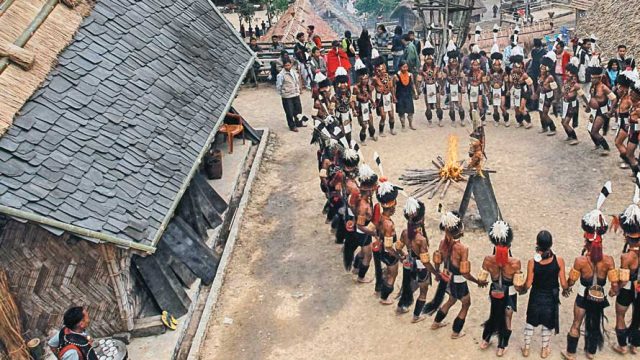The ride from Kohima to Botsa, and further on up the hill to Tuophema, can feel worlds apart from the uphill ascent from Dimapur to Kohima. As you head deep into northern Angami territory, the real roads and lives of the Nagas unfold. In fact, for those looking to head to Tuophema not just to get away from the crowds but to discover real Naga life, we would recommend taking the Tuophema community bus that leaves almost every day around 1.00 pm from High School Junction. Timings and frequency may vary, so call the tourist village a couple of days ahead and plan. Get there early to secure a seat, and be prepared to ride alongside pets and chickens.
To head into the state and see peoples’ lives, livelihoods and lifestyles up close is a novel experience. Tuophema Tourist Village, set up in 2001 as a community effort by the people of Tuophema, offers just that. Self-funded, organised and designed, the tourist village was the result of the joint efforts of the different khels or clans from within the village. It offers a unique glimpse into rural life of a different kind than most Indians would be familiar with.
A traditional welcome gate leads to the village, dominated by a large tree called the War Head Tree, where enemy heads were once hung as war trophies. Along with nights spent in traditional Angami houses, the tranquil tourist village, run by a team of young locals, offers a peaceful retreat, mountain and valley vistas, cultural and educational programmes, a local museum, and guided walks through the village.

With just over 500 families, this is a tightly knit village. The history of Tuophema is said to go back to 1461 CE. The old northern gate is one the village’s few historical remains. A guided walk around the village, arranged by the helpful staff at the tourist village, will take you past the old and new sections of the village, which include Baptist churches, an amphitheatre, and a lovely unoccupied house built in memory of the village founder.
Close to the huts is a small museum that was set up in 2006. This well-lit room displays Angami dresses, headdresses, weapons and jewellery, along with household and ritual items relevant to this area.
Time your trip with the annual Angami festival of purification, known as Sekrenyi, a wonderful display of rituals and ceremonies; it is held between the 25th and 27th of February every year. Water is a significant source for the Angamis, as evident in the rituals of the first day of the festival. The village well is cleaned the night before the festival and village youth guard it zealously, since no one is allowed to collect water from it after it has been cleaned. On the second day the young men rise early and proceed to the well to wash.

Another interesting ritual during the festival is called dzuseva or ‘touching the sleeping water’, in which men don two new shawls (the black mhoushu and the white lohe) and sprinkle water on themselves; this is said to wash away their misfortunes. There are other rituals involving rice beer, which might be of particular interest to fascinated tourists who can enjoy some of the inebriating drink with the locals as part of the feast.
WHERE TO STAY AND EAT
The Tourist Village (Cell: 09436832075, 08014926733; Tariff: ₹2,300-2,500 for a double occupancy hut; W touristvillagetuophema.com) comprises 12 huts, all built by the different clans in the villages. The spacious huts come with comfortable king-sized beds and attached bathrooms with hot-water facilities.
The young locals who maintain the tourist village also serve up some delicious Naga grub for their guests (approximately ₹250 per person per meal). Expect delicious home-made dal, pork, chicken and vegetable dishes.
When to Go October-May, when it is not raining Location Part of the northern Angami region, Tuophema is located in the Kohima District Air Nearest airport: Dimapur Rail Nearest rail: Dimapur




